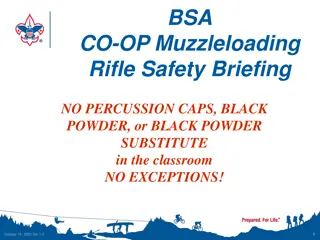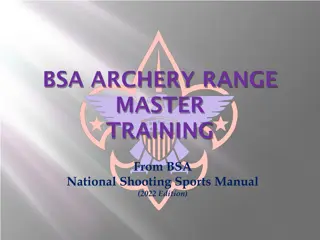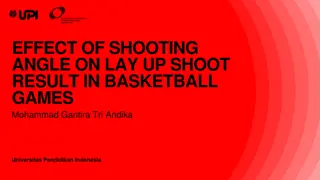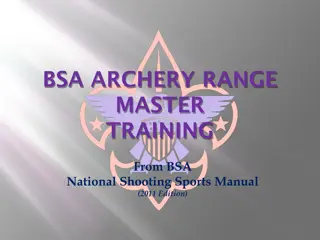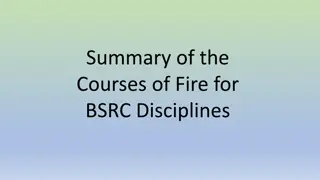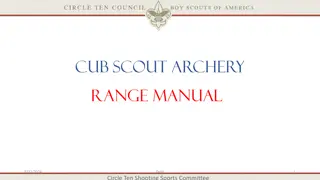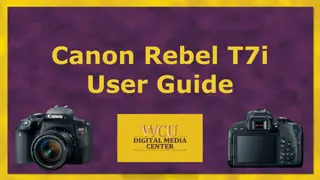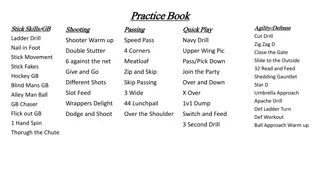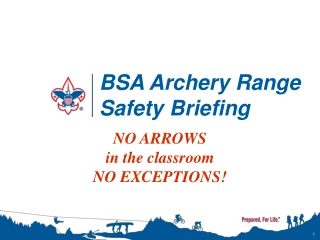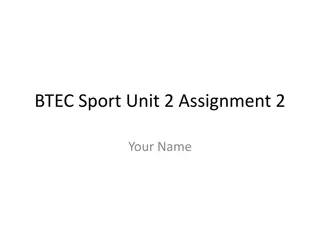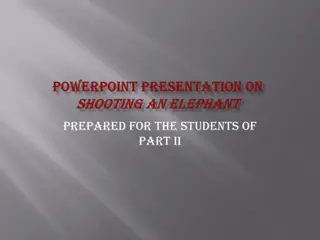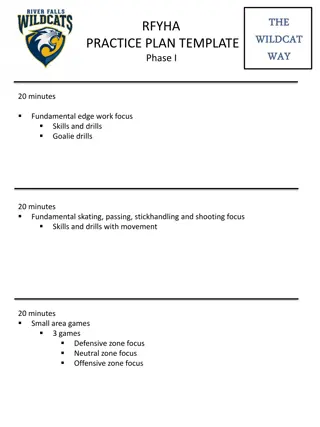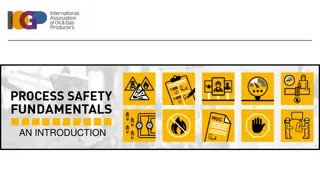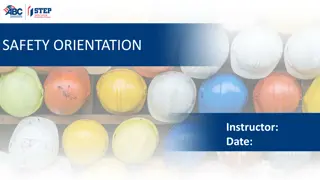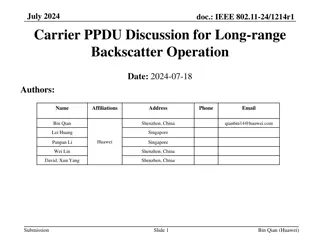Comprehensive Rifle Range Safety and Shooting Fundamentals Guide
Learn essential NRA Gun Safety Rules, rifle parts, shooting fundamentals, and demonstration of rifle operation in this comprehensive guide for beginning shooters. Discover how to determine your dominant eye, bench rest position, and more. Stay safe and develop the necessary skills to shoot a rifle under supervision.
Download Presentation

Please find below an Image/Link to download the presentation.
The content on the website is provided AS IS for your information and personal use only. It may not be sold, licensed, or shared on other websites without obtaining consent from the author. Download presentation by click this link. If you encounter any issues during the download, it is possible that the publisher has removed the file from their server.
E N D
Presentation Transcript
BSA Rifle Range Safety Briefing NO AMMUNITION in the classroom NO EXCEPTIONS! 1
Orientation Goal To provide beginning shooters with the knowledge, skills, and attitude necessary to shoot a rifle safely under the direct supervision of a NRA Certified Rifle Instructor or Certified NCS Shooting Sports Director. 2
NRA Gun Safety Rules ALWAYS keep your gun pointed in a safe direction ALWAYS keep your finger off the trigger until ready to shoot ALWAYS keep your gun unloaded until ready to use 3
Rifle PartsAir Rifle Loading Port Rear Sight Chamber Front Sight Barrel Grip Comb Muzzle Piercing Tube Cap Butt Pellet Magazine Trigger Safety Forearm Trigger Guard Toe 4
Rifle PartsBolt Action Chamber Barrel Rear Sight Grip Safety Comb Front Sight Bolt Butt Muzzle Forearm Box Magazine Trigger Bolt Handle Trigger Guard Toe 5
Demonstrate Rifle Operation Instructor demonstration only Loading with Dummy Ammo Cocking Firing Dry-fire only with Dummy Ammo Unloading During Live-fire on the range, your instructor will load and unload the rifle for you. 6
Shooting Fundamentals Determining the Dominant Eye Extend arms forward and form opening between the hands With both eyes open, look at a distant object through opening Bring hands to face while looking at object Opening will be aligned with the dominant eye 7
Rifle Shooting Fundamentals 1. AIMING (sight alignment & sight picture) 2. BREATH CONTROL 3. HOLD CONTROL 4. TRIGGER CONTROL 5. FOLLOW-THROUGH 8
Bench Rest Position Feet flat on the ground with the legs relaxed. Seated directly behind the front support with slight lean forward. Butt of the rifle in the shoulder close to neck. Elbows on the table to support the rifle. Support hand under the Forearm. Trigger hand. Face firmly against the stock with eye looking straight down the sights. Align the position to target. 9
Prone Supported Position Feet and legs are flat on the ground with the legs relaxed. Butt of the rifle in the shoulder close to neck. Elbows on the ground to support the rifle. Support hand under the Forearm. Trigger hand. Face firmly against the stock with eye looking straight down the sights. Align the position to target. 10
FUNDAMENTALS Aiming Notch Rear and Post Front Sight FRONT SIGHT IS IN SHARP FOCUS Sight Alignment With Post-and-Notch sights: The tops of the front and rear sights are even Sight Picture 6 O'clock Hold on the Bullseye The front post is centered in the rear notch
FUNDAMENTALS Aiming Aperture Rear and Post Front Sight FRONT SIGHT IS IN SHARP FOCUS Sight Alignment Aperture Rear and Post Front Sight Sight Picture 6 O'clock Hold on the Bullseye The tops of the front is center in the rear sights aperture
FUNDAMENTALS Aiming Aperture Rear and Aperture Front Sight FRONT SIGHT IS IN SHARP FOCUS Sight Alignment Aperture Rear and Post Front Sight Sight Picture Bullseye is center in the front sight aperture The front aperture is center in the rear sights aperture
FUNDAMENTALS Aiming Scope FOCUS ON THE TARGET Sight Alignment Looking through the scope , You see the whole scope tube (not just small hole in tube) Sight Picture Cross Hairs are centered on the target
Shooting Fundamentals Breath Control Body movement while breathing can produce gun movement that impairs shooting. Stop breathing momentarily while firing the shot! (Respiratory pause) 15
Shooting Fundamentals Hold Control Body movement affects the shot. Hold your body still. Hold control allows you to maintain the proper sight picture and sight alignment during the process of firing the shot. 16
Shooting Fundamentals Trigger Control Trigger is pulled straight to the rear in a smooth, continuous manner without disturbing the sight alignment. Gradually and evenly increasing pressure until the mechanism releases. SURPRISE yourself when the gun shoots. 17
Shooting Fundamentals Follow-Through In Rifle Shooting: Follow-through means to maintain aiming (perfect sight alignment and acceptable sight picture), breath control, hold control, and trigger control until the gun settles back into the aiming area after firing. 18
Shooting Fundamentals The Fundamentals A Review 1. Maintaining perfect sight alignment and acceptable sight picture. AIMING 2. Stop breathing. BREATH CONTROL 3. Holding still. HOLD CONTROL 4. Moving only your trigger finger. TRIGGER CONTROL 5. To maintain position, and continue aiming, breath control, hold control, and trigger control until the gun settles back into the aiming area after the shot is fired. FOLLOW-THROUGH 19
Most Important Fundamentals! NOTE The TWO most IMPORTANT shooting fundamentals are .. Maintaining sight alignment AIMING Moving only the trigger finger TRIGGER CONTROL 20
Range Safety Briefing Range layout Ready Area Firing Line Target Area Back Stop 21
Range Safety Briefing NRA Safe Gun Handling Rules ALWAYS keep your gun pointed in a safe direction. ALWAYS keep your finger off the trigger until ready to shoot. ALWAYS keep your gun unloaded until ready to use. 22
Range Safety Briefing Other Safety Rules Know your target and what is beyond Wear eye and ear protection as appropriate Never use alcohol or drugs before or while shooting Be aware that certain types of guns and many shooting activities require additional safety precautions Range Commands Commence Firing Cease Firing 23
At The Firing Point One instructor will be at each firing point. 1. The instructor will hold the rifle by the forearm. 2. Place your hands on the grip. When you have control of the rifle, say Thank you and the instructor will let go. 3. You will then Dry-fire. TAKE YOUR TIME. Focus on safety and the shooting fundamentals. When you are comfortable, tell the Instructor you are ready to shoot. 4. Your instructor will then load the rifle and hold it by forearm. 5. Place your hands on the grip. When you have control of the rifle, say Thank you and the instructor will let go. 6. You will Live-fire the prescribed number of shoots. Strive for consistent shot groups. 24
Questions Do you have any questions before you move to the Ready Area? 25


